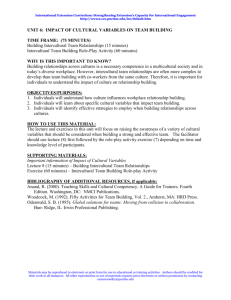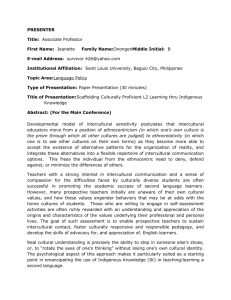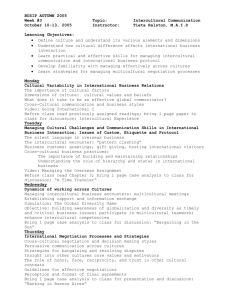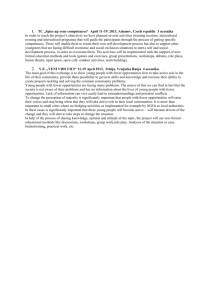SherwoodSlides
advertisement
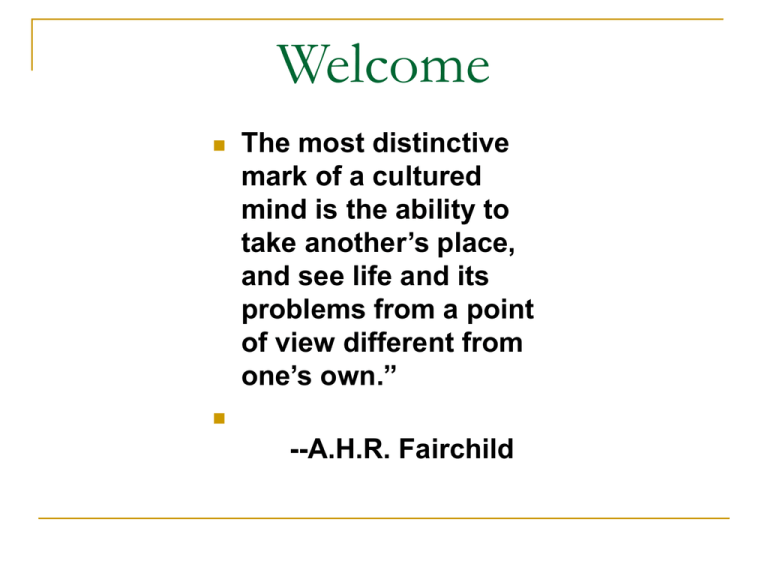
Welcome The most distinctive mark of a cultured mind is the ability to take another’s place, and see life and its problems from a point of view different from one’s own.” --A.H.R. Fairchild Success in the World The Roles of Cultural Competencies Personal & Professional The Rubenstein School: 5 September 2006 SNR 6 – POSTING COPY Presenter: Sherwood Smith, IPS & CCP UVM Overview Introductions A. Personal Experience: Defining culture B. Social Construction C. Intercultural Communication Skills D. Identity: Internal & External E. Personal and/or Professional F. Applications and Goals: G. Question & Answer KEY CULTURAL CONCEPTS Culture can impact levels of conflict, cooperation, and community Cultures have rules Culture is learned, transmitted and impacts behavior Culture changes understanding and values Stress in People's Experiences * Disconfirmed Expectancies * Belonging * Ambiguity * Cognitive Dissonance * Stigma (Xenophobia/”ism”) Language: The Question of Definition Intercultural Communication: Bennett, M. (1998) Basic Concepts of Intercultural Communication. Intercultural Press, ME Diversity Glen, John M. ( 1996). Highlander: No Ordinary School. Knoxville, Tennessee: The University of Tennessee Press. Social Justice Adams, M., Bell, L.A. & Griffin, P. (Eds.) (1997). Teaching for diversity and social justice: A source book. New York: Routledge. “Ism” Hilliard, Asagi G. III. (1997).Teaching/Learning Anti-Racism: A developmental Approach. New York, NY: Teachers College Press. Multiculturalism: Banks, James A. (1994). Multiethnic education: Theory and Practice (3rd Edition). Boston, MA: Allyn and Bacon Cheatham H. 1991. Cultural Pluralism On Campus. ACPA Media Board Publ. CULTURE IcebergmodeCulture can be compared to an iceberg, because so much goes undetected. So that much of the mass is often ignored. The influences of cultural elements need to be explicitly explored rather than taken forgotten or ignored. Below are list some of the cultural issues that impact on evaluation: LANGUAGE ARTS LITERATURE DRAMA MUSIC DRESS DANCING GAMES SPORTS COOKING /////\\\\\\//////\\\\\//////\\\\\\//////\\\\\////\\\\\///////\\\awareness level NOTIONS OF MODESTY CONCEPTS OF BEAUTY EDUCATION CHILD RAISING RULES OF DESCENT COSMOLOGY RELATIONSHIP TO THINGS, ANIMALS & PLANTS COURTSHIP PRACTICES CONCEPT OF JUSTICE MOTIVATION TO WORK CRITERIA FOR LEADERSHIP DECISION MAKING PROCESSES DEITIES IDEAS OF CLEANLINESS LOCUS OF CONTROL THEORY OF DISEASE PHYSICAL SPACE ROLES IN RELATION TO STATUS BY AGE, GENDER, CLASS, KINSHIP, OCCUPATION, RELIGION,.... CONVERSATIONAL PATTERNS IN VARIOUS SOCIAL CONTEXTS, CONCEPTION OF TIME AND SPACE DEFINITION OF SANITY, FRIENDSHIP, LOVE, MURDER, LIFE, GENDER, FACIAL EXPRESSIONS PREFERENCES FOR COMPETITION, COOPERATION, INDIVIDUALISM OR GROUPING SIN OR GRACE NOTION OF ADULTHOOD NOTION OF LOGIC AND VALIDITY PHYSICAL SPACE ARRANGEMENTS PATTERNS OF HANDLING EMOTIONS LIFE ACCEPTANCE OF FRUSTRATION AND/OR PAIN Beyond the Tip of the Iceberg Author: Jerome Hanley “Understanding the cultures of the youth we serve requires more than words and good intentions. The journey toward cultural competence requires the willingness to learn from those experiences and act.” PART B Social Construction Topics 1. Socialization - Cultural Communication of Power & Paradigm 2. Knowledge -Transmission of information 3. Personal and Institutional Beliefs - Norms, Values & Learning Styles PART C Intercultural Communication Power Distance and Privilege Individual vs. Group PART D Power Distance Relationships (Identity Development) Privileged Marginalized Dominant “Majority” Marginalized “Minority” Ponterotto & Pedersen. (1993). Preventing Prejudice. Sage. CA PART E Personal & Professional (Institutional Norms) Institutions: Consist of cognitive, normative, and regulative structures and activities that provide stability for the status quo and define the meanings of normative social behavior. Adams, M., Blumenfeld, W.J., Castañeda, R., Hackman, H.W., Peters, M.L., & Zúñiga, X. (Eds.) (2000). Reading for diversity and social justice: An anthology on racism, anti-Semitism, sexism, heterosexism, ableism, and classism. New York: Routledge. F: Applications for Practice 1. Individual or Institutional Burn, Shawn Meghan. (2000). Women Across Cultures: A Global Perspective. Mountain View, CA: Mayfield Publishing Company. 2. Skill Levels - Consciousness & Competency Summerfield, E. (1997). Survival Kit for Multicultural Living. Intercultural Press: ME Applications and Goals Systemic Issues Nurture Understanding: experiences, histories and contexts Create Awareness: internal and external Build Abilities and Skills: do and teach Do Assess: explain, share and institutionalize Five Personal Skills for Survival Know yourself Know how to adapt Know when the paradigm shifted Sharing the knowledge We do not know everything… Assessing Allies and Bigots SAMPLE ACTIONS SHEETS Personal Professional Attend a new cultural event Attend a social justice focused workshop Have a discussion with friends Attend a film or lecture Read a book Investigate research on specific topic / issue Attend a power & privilege workshop Survey attitudes and beliefs of peers on cultural issues Invite a speaker G Questions & Discussion 1. Discussion and applications 2. Feedback Summary Personal Experiences Social Construction Intercultural Communication Skills Identity Development Personal and Professional Applications and Goals Feedback Professional Applications Content Allen, T. (1994) The Invention of the White Race. Verso Astin, Alexander W., (1993) What Matters in College? San Francisco: Jossey-Bass Publishers Diamond, Jared. (1999). Guns, Germs, and Steel: The Fates of Human Societies. New York: W.W. Norton & Co. Stromquist, Nelly P. (1991). Daring to be different: the choice of non conventional fields of women Students. New York, NY: Institute of International Education Concepts Peggy.(1995) “White Privilege, Male Privilege” in Race, Class, Gender. ed. Anderson, M.L. & Collins, P.H., Wadsworth Publishing Rothschild, J. (1983). Machina Ex Dea: Feminist Perspectives on Technology. NY, NY. Pergamon Press. *Brislin, R. (1993). Understanding culture’s influence on behavior. Fort Worth, TX: Harcout Brace College Publishers. Creativity Summerfield, Ellen (1993). Crossing Cultures Through Video Film. Yarmouth, Maine USA: Intercultural Press Inc. Bull, Barry L., Fruehling Royal T., and Chattergy, Virgie (1992) The Ethics of Multicultural and Bilingual Education. New York, Teacher's College Press *Carr, W. & Kemmis, S. (1986). Becoming critical: Education, knowledge and action research. London, UK: Falmer Press. CRITCAL CONCEPT “I truly believe that everyone’s education is qualitatively improved when we are confronted with an analysis of our society, when we are asked in an academic setting to struggle with viewing ourselves from another’s perspective and seeing the relationships between our thoughts and ideology that repress/oppress others. We need to be jolted into seeing how our attitudes fit into a systemic application of power within our society. Lazy is a power-filled word. We need to begin to own how we use our power….” Source: Power Works, Power Plays, by John Fiske ( New York, Verso. 1993) Understanding & Awareness PARADIGM SHIFT “It is directed at promoting personal change, cognitive restructuring, or what Kuhn (1962), Mestenhauser (1981) and M. Bennett (1993) refer to as a paradigm shift. We agree with Alder (1976) that substantive culture learning cannot occur without the acquisition of a new worldview.” Adler’s useful observation that multiculturalism as a skill is the ability to operate effectively in a multiplicity of cultural settings and to integrate those diverse cultural perspectives into one’s personality. The development of this skill can pose acute personal dilemmas.” Landis and Bhagat. 1996. Handbook of Intercultural Training. Sage Publishers.
